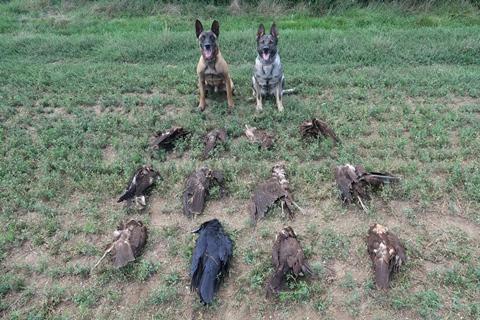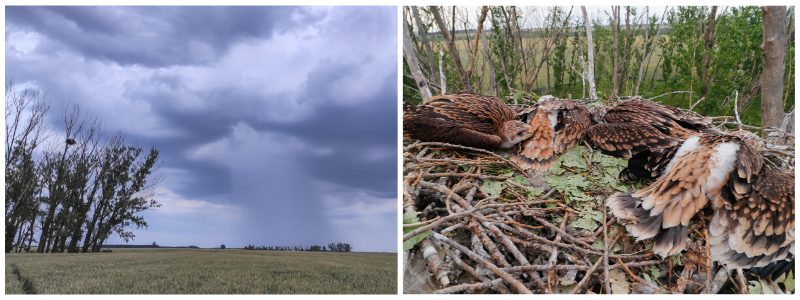Story by PannonEagle
Over a hundred poisoned baits and more than 50 poisoned animal carcasses have been found near the town of Tura, in Hungary. 96% of the carcasses found were protected birds. This gruesome discovery was made by the carcass and poison detection dog unit of BirdLife Hungary, the ranger service of Duna Ipoly National Park Directorate, and volunteers.
Considering the number of baits, this is the most serious intentional poisoning incident ever recorded in Hungary. Thanks to the quick action of nature conservation organisations, a local ecological catastrophe was avoided. The evidence suggests that the perpetrators used large quantities of strong neurotoxins on the baits. These poisoned baits are not only harmful for birds of prey and smaller predators but could possibly be dangerous to other animals and humans as well.
Both the method and the execution suggest that the perpetrators tried to completely eradicate the predatory species from a large area. Poisoning cases like this have huge conservation risks, because regardless of the original target, 96% of the victims were protected or highly protected bird species.
The victims of this crime were: 44 protected Western Marsh-harriers (Circus aeruginosus), a Eurasian Buzzard (Buteo buteo), two Tree Pipits (Anthus trivialis), a strictly protected Black Kite (Milvus migrans) and two foxes. We also found a strictly protected Montagu’s Harrier (Circus pigargus)that was poisoned but still alive. Thanks to the rapid veterinary treatment, the condition of the Montagu’s Harrier is now stable, but it is still uncertain whether the bird can be repatriated.
BirdLife Hungary’s dog unit, the ranger service of Duna-Ipoly National Park Directorate and volunteers have been working tirelessly in the past few days to gather all the poisoned baits and carcasses in order to avoid further destruction. The Imperial Eagle pair, whose territory is in the vicinity, have not been affected so far, but the risk for them to find an undiscovered bait or a poisoned carcass is still high.
UPDATE: POISON DOMINO EFFECT
The situation is even worse than we thought. Several new killing hotspots have been detected and the latest results revealed that the baits had been scattered over nearly 8,000 hectares, practically covering the entire area of the Szent András Dombi (St. Andrews Hill) Hunting Club.
The identity of the criminals and their motives are still unknown. One possible indulgent explanation could be that the perpetrators wanted to protect their livestock: however, the scale of the poisoning makes this unlikely. The other most common reason for poisoning is the false belief that killing predators yields larger quantities of small game for sport hunting.
Since the latest news, the authorities have found even more baits and dead animals. Domestic animals are victims too: a dog also ate a poisoned bait (fortunately, it survived). The search dogs found two dead Marsh Harriers (Circus aeruginosus) that were concealed, suggesting that the perpetrators had returned to the crime scene in attempt to cover their tracks. The timing of the poisoning was atypical as most of the previous poisonings have occurred during winter and spring. Perhaps it was deliberately planned during the holiday season so that nature conservationists would take longer to find out.
The numbers are shocking. So far, the authorities have found 114 poisoned animals and 132 baits. Among the victims, there are 93 specimens of eight protected species: 76 Marsh Harriers (Circus aeruginosus), 7 Common Buzzards (Buteo buteo), 3 Common Raven (Corvus corax), 2 Black Kites (Milvus migrans), 2 Tree Pipits (Anthus trivialis), one Montagu’s Harrier (Circus pygargus) and a Calosoma auropunctatum beetle. In addition to these, dogs, cats, foxes, two Carrion Crows and one European Jay also fell victim to the poisoning; as well as six other animals that couldn’t even be indentified because of the condition they were in.
To our knowledge the Gödöllő Police Headquarters have carried out six on-site investigations so far. According to the police statement, the laboratory test revealed that the perpetrators used a highly toxic neurotoxin. We urge hikers, bikers, dog-walkers and anyone working outdoors to avoid touching anything suspicious. If you suspect poisoning, please contact the authorities immediately!





